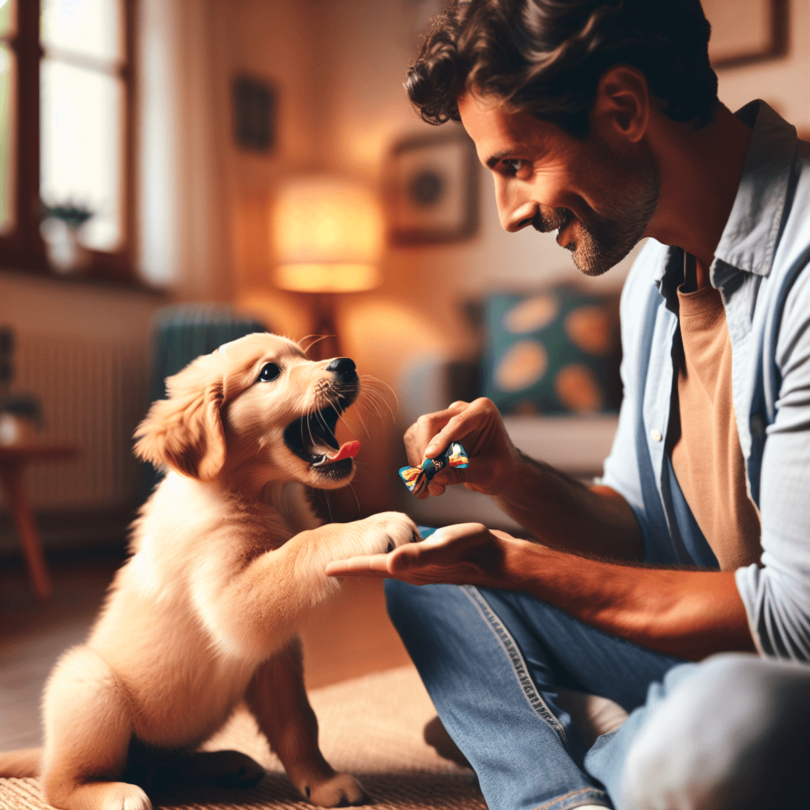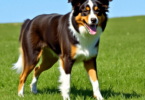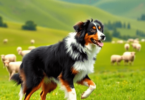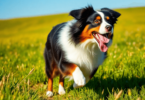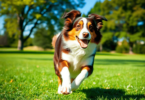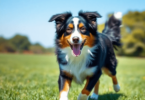Introduction
Addressing puppy biting behavior is crucial for fostering a harmonious relationship with your furry friend. Puppy biting, while a natural part of their development, can quickly become problematic if not managed appropriately. Early intervention ensures that those playful nips don’t turn into more serious issues as your puppy matures.
Patience and consistency are key to effective puppy behavior training. Teaching your pup acceptable behaviors takes time and repetition, but the reward is a well-mannered companion who understands boundaries. So, roll up your sleeves and get ready to dive into the exciting journey of how to train a puppy to stop biting!
Understanding Puppy Biting Behavior
Understanding puppy behavior can be a delightful yet challenging endeavor, especially when it comes to puppy mouthing behavior. Puppies bite for various reasons:
- Exploration: Just like human babies, puppies explore the world with their mouths. This is their way of learning about their environment.
- Playfulness: Biting during play is a natural part of puppyhood. It’s how they engage with their littermates and humans alike.
- Natural Instincts: Puppies have an inherent need to chew, which is intensified during the teething phase. Those 28 sharp teeth are not just for show—they’re tools for exploration and relief from gum discomfort.
Littermates play a crucial role in teaching bite inhibition during early development. When puppies play together, they learn the limits of their bites. A hard bite results in a yelp from the bitten sibling, signaling that the bite was too intense. This feedback loop helps puppies understand acceptable levels of pressure.
Incorporating these insights into training can make a world of difference. Realizing that biting is a normal, instinctual behavior allows for more effective and compassionate training methods.
1. Teaching Bite Inhibition
Bite inhibition is a critical skill for puppies to learn, shaping their social interactions and ensuring they understand how to control the intensity of their bites. It essentially helps them distinguish between playful nipping and harmful biting.
Here are some effective training techniques for puppies to teach bite inhibition:
- Vocal Cues: When your puppy bites too hard, use a high-pitched “ow!” This sound mimics the yelps they would hear from their littermates, signaling that they’ve applied too much pressure.
- Reinforcing Gentle Behavior: Immediately after your vocal cue, stop playing briefly to let your puppy process the feedback. If they resume play gently, shower them with praise and rewards. This positive reinforcement encourages soft mouthing.
- Practice Sessions: During playtime, allow your puppy to mouth your hands gently. If they start getting rough, repeat the “ow!” followed by a short break. Consistency is key here.
Training your puppy in bite inhibition not only prevents painful nips but also teaches them essential social cues for interacting with other dogs and people.
2. Providing Alternatives to Biting
Redirecting puppy bites towards more suitable objects is a game changer. Puppies need to chew—it’s part of their natural development and a way to explore the world around them, as explained in this Pet Health Network article. Instead of letting them nibble on your fingers or toes, offer acceptable chew toys that can withstand their enthusiastic gnawing.
Why Chew Toys Matter
Chew toys are essential for several reasons:
- Safety: Human skin isn’t designed to handle sharp puppy teeth.
- Distraction: Chew toys keep puppies occupied and away from inappropriate chewing targets.
- Teething Relief: They help soothe the discomfort of teething.
Top Recommendations for Chew Toys
Choosing the right chew toy can make all the difference:
- Rubber Toys: Durable and great for aggressive chewers. Brands like KONG offer toys that can be stuffed with treats for added engagement.
- Nylon Bones: Long-lasting and satisfying for puppies who love a good gnaw.
- Rope Toys: Excellent for interactive play and dental health, as they help clean teeth while chewing.
Strategies for Redirection
To effectively redirect your puppy’s biting, which can sometimes feel overwhelming as noted in this Quora discussion, you might consider these strategies:
- Keep Toys Handy: Always have a chew toy within reach to quickly swap out for your hand or foot.
- Praise and Reward: When your puppy chooses the toy over human skin, shower them with praise or give a small treat.
- Consistency is Key: Make this swap every time they start biting inappropriately to reinforce the behavior.
By providing appealing alternatives and using consistent redirection techniques, you’ll help your puppy learn what’s appropriate to bite—and save your fingers in the process! If you find yourself struggling with persistent biting issues, it might be helpful to seek advice from professionals through platforms like Reddit where many dog owners share their experiences and solutions.
3. Implementing Time-Outs for Excessive Biting
When your puppy becomes overly excited and starts nipping excessively, a time-out can be an effective training tool to manage biting behavior. This technique helps your pup understand that biting leads to an immediate end of playtime, teaching them to control their impulses.
Step-by-Step Guide on Implementing Time-Outs
- Immediate Response: As soon as your puppy bites too hard, say a firm “No!” or “Ouch!” and stop all interaction.
- Ignore the Puppy: Turn away and avoid eye contact for about 20-30 seconds. This brief period of ignoring acts as a cooling-off phase.
- Isolate If Necessary: If the biting continues, calmly place your puppy in a designated time-out area (a small room or gated-off space) for 1-2 minutes.
- No Drama: Keep the process calm and devoid of any excitement. The goal is to remove attention, not to scare your pup.
- Resume Play: After the time-out, allow your puppy to rejoin you and resume play. If they bite again, repeat the process.
Consistency is key with this method; ensure every member of the household follows the same procedure to reinforce the lesson effectively.
By implementing time-outs correctly, you not only manage biting behavior but also foster a calm and respectful environment for both you and your furry friend.
4. Encouraging Gentle Play Techniques
When it comes to gentle play with puppies, setting the tone early is essential. Gradually tighten the rules around play intensity to ensure that playful mouthing doesn’t escalate into aggressive behavior.
Gradual Rule Tightening
- Start Simple: Allow some light mouthing initially but set limits.
- Decrease Pressure: As days pass, reduce the acceptable pressure of their bites.
- Zero Tolerance: Eventually, aim for zero tolerance on biting and mouthing.
Use vocal cues like “gentle” or “easy” to reinforce these rules.
Non-Contact Games
To manage playful mouthing effectively, introduce non-contact games that keep their sharp little teeth away from your skin:
- Fetch: Classic and effective, fetch channels your pup’s energy into chasing and retrieving, rather than nipping at you.
- Tug-of-War: Great for interactive fun, ensuring you use a sturdy toy designed for tugging.
- Hide and Seek: This game stimulates your pup’s mind while keeping their mouth occupied with something other than your fingers.
These games not only provide mental and physical exercise but also teach your puppy how to engage without using their mouth inappropriately.
5. Positive Reinforcement Strategies
Using positive reinforcement is a game-changer in puppy training techniques, especially when teaching your furry friend to play gently. It’s all about rewarding desired behaviors, which helps to shape them into habits.
Examples of Rewarding Desired Behaviors (Praise, Treats)
- Verbal Praise: A simple “good boy!” or “good girl!” can work wonders. Puppies love hearing that they’re doing something right.
- Treats: Small, tasty rewards are like gold stars for your pup. Keep them handy during playtime to reinforce gentle behavior immediately.
- Affection: Belly rubs, ear scratches, or a good cuddle session can also serve as powerful rewards.
Creating a consistent reward system is crucial. Ensure your puppy receives immediate rewards whenever they exhibit appropriate play styles without excessive biting. This helps them make the connection between their actions and the positive outcome.
Imagine this scenario: Your puppy is playing and starts mouthing your hand gently. As soon as they do, you say “Good gentle!” and give them a small treat. Repeat this consistently, and you’ll notice your puppy starting to prefer gentle mouthing over rough nipping.
The Magic of Consistency
Consistency is key in positive reinforcement. Every time your puppy plays gently or stops biting when asked, reward them:
- Immediate Response: Timing is everything. Reward your pup as soon as they display the desired behavior.
- Mixed Rewards: Switch it up between verbal praise, treats, and affection to keep things exciting for your pup.
- Clear Signals: Use clear, consistent signals or commands so your puppy knows exactly what behavior is being rewarded.
Positive reinforcement not only teaches puppies what behaviors are acceptable but also strengthens the bond between you and your furry friend. Through patience and consistent rewards, you’ll guide them towards becoming well-mannered companions who understand how to interact gently with people and other dogs.
6. Avoiding Physical Punishment Methods
Why Physical Punishment is Ineffective
Physical punishment, like hitting, shaking, or using shock collars, might seem like a quick fix for biting behaviors. However, these methods can backfire spectacularly.
- Breakdown of Trust: Your puppy looks up to you as their protector and friend. Using physical force can shatter this trust, making them afraid rather than compliant.
- Fear-Based Responses: Instead of learning what not to do, your puppy might just become fearful. A scared puppy is more likely to develop anxiety-related behaviors that are harder to correct in the long run.
Understanding the Impact of Negative Attention on Behavior
Negative attention such as yelling or scolding might feel like you’re addressing the problem head-on. But hold your horses!
“Even negative attention is still attention.”
When puppies receive any form of attention after biting—be it positive or negative—they may interpret it as a reward. The act of nipping gets them noticed, which can inadvertently encourage more biting.
- Reinforcing the Wrong Behavior: By reacting loudly when bitten, you might be teaching your pup that biting results in an exciting response.
- Stress and Fear: Constant negative reinforcement can make your puppy anxious and stressed, leading to other undesirable behaviors.
Alternatives to Negative Reinforcement
Instead of focusing on what not to do, try these kinder methods:
- Use vocal cues like a high-pitched “ow!” to indicate discomfort.
- Redirect their biting towards appropriate chew toys.
- Implement time-outs if they become overly excited.
Training a puppy requires patience and consistency, but with positive methods, you’ll foster a loving and well-behaved canine companion.
7. The Role of Socialization in Training
Training your puppy to stop biting isn’t just about direct interventions; it also involves effectively socializing your pup. Early exposure to different environments, people, and well-mannered dogs plays a pivotal role. This exposure helps puppies develop bite inhibition skills through controlled interactions. They learn appropriate pressure levels during play, reducing the chances of accidental nips and bites.
Benefits Of Enrolling Your Puppy In Supervised Classes With Other Dogs
Taking your puppy to supervised classes offers numerous advantages:
- Structured Activities: Professional trainers design group classes specifically for young pups. These sessions often include structured activities that enhance their social competence.
- Controlled Environment: Such classes provide a controlled setting where your puppy can interact with other dogs without the risk of overexcitement-induced mouthing incidents.
- Learning from Peers: Puppies learn a lot from their peers. Observing well-mannered dogs helps them understand the dos and don’ts of social interactions.
- Expert Guidance: Trainers can offer personalized advice and techniques tailored to your puppy’s needs, ensuring they get the most out of each class.
Puppy Socialization Benefits
Exposing your puppy to various stimuli is crucial for their development. Here are some key benefits:
- Enhanced Confidence: Regular exposure to new environments builds confidence, making them less likely to act out of fear or anxiety.
- Better Behavior: Socialized puppies tend to be better behaved, as they’ve learned how to interact appropriately with different beings and settings.
- Reduced Aggression: Proper socialization reduces the likelihood of aggressive behavior since your puppy learns acceptable ways to express themselves.
- Improved Bite Inhibition: Through play with other dogs, puppies learn the boundaries of acceptable biting and mouthing.
Incorporating socialization into your training regimen not only curbs biting but also ensures a well-rounded, confident pup ready to take on the world!
8. Calming Techniques For Puppies
When your puppy gets a bit too hyper, you’ll want some calming techniques in your toolkit. Here are some strategies to help your pup stay calm and relaxed during training sessions:
1. Create a Cozy Retreat
Designate a quiet spot in your home where your puppy can retreat when feeling overstimulated. Think of it as their personal zen den. A comfy bed, soft blankets, and maybe even a favorite toy can make this space inviting.
2. Practice Calming Signals
When your puppy starts getting too hyperactive, gently tuck their little paws away or place them in a resting position. This can signal to them that it’s time to calm down.
3. Calm Touch
Slowly petting your puppy or giving them a gentle massage can have a soothing effect. Focus on areas like the chest and shoulders.
4. Quiet Time
Sometimes, all they need is a break from the action. Allowing some downtime can help reset their energy levels.
5. Gentle Commands
Use soft-spoken commands like “sit” or “stay” paired with treats to encourage calm behavior.
These calming techniques for puppies not only help manage high-energy moments but also reinforce positive behavior during training sessions.
9. Seeking Professional Help When Needed
Sometimes, despite your best efforts, puppy biting can feel like an unsolvable puzzle. This is where seeking professional help for dog training can make all the difference.
Signs You May Need a Certified Trainer
- Persistent Aggression: If your puppy displays continuous aggressive biting, regardless of consistent training, it might be time to call in a pro.
- Feeling Overwhelmed: Training a puppy is no small feat. If you’re stressed out, and progress seems non-existent, a trainer specializing in mouthing issues can provide tailored strategies and much-needed support.
Benefits of Professional Assistance
Certified trainers are equipped with advanced techniques and insights:
- They can quickly identify underlying issues that might be contributing to persistent biting.
- A structured training plan designed specifically for your pup’s needs.
- Hands-on demonstrations and real-time feedback during sessions.
“A professional trainer offers not just solutions but also peace of mind knowing you’re on the right track.”
Finding the Right Trainer
When looking for a trainer:
- Check Credentials: Ensure they are certified by recognized organizations.
- Specialization in Mouthing Issues: Not all trainers are created equal; find one with specific expertise in dealing with biting behaviors.
- Reviews and Testimonials: Look for positive feedback from other pet parents who faced similar challenges.
In those moments when biting seems like an insurmountable challenge, remember that help is just a call away. Seeking professional guidance can transform your training journey from daunting to delightful!
FAQs (Frequently Asked Questions)
Why is it important to address puppy biting behavior?
Addressing puppy biting behavior is crucial for a harmonious relationship with your furry friend. It helps prevent future behavioral issues and ensures safe interactions between your puppy and people or other pets.
What are some effective techniques for teaching bite inhibition?
Teaching bite inhibition involves using vocal cues, like a high-pitched ‘ow!’, to signal discomfort when bitten too hard. Reinforcing gentle behavior with praise and rewards encourages soft mouthing during playtime.
How can I redirect my puppy’s biting urges?
Redirecting your puppy’s biting urges can be achieved by offering appropriate chew toys instead of allowing access to human body parts. Providing safe and engaging chew toys and actively guiding your puppy towards them during play sessions is essential.
What should I do if my puppy bites excessively?
Implementing time-outs can be an effective training tool when your puppy becomes overly excited and starts nipping excessively. A step-by-step guide on how to implement time-outs without causing stress or fear in your pup can help manage this behavior.
How does socialization benefit my puppy’s training?
Socialization is vital as it exposes your puppy to various environments, people, and well-mannered dogs at an early age. This helps them develop good bite inhibition skills through controlled interactions where they learn appropriate levels of pressure during playtime exchanges.
When should I seek professional help for my puppy’s biting issues?
You should seek professional help if you notice persistent aggression despite following recommended techniques consistently over time or if you feel overwhelmed by the process without any progress being made at all. A certified trainer specializing in addressing mouthing issues can provide valuable assistance.
